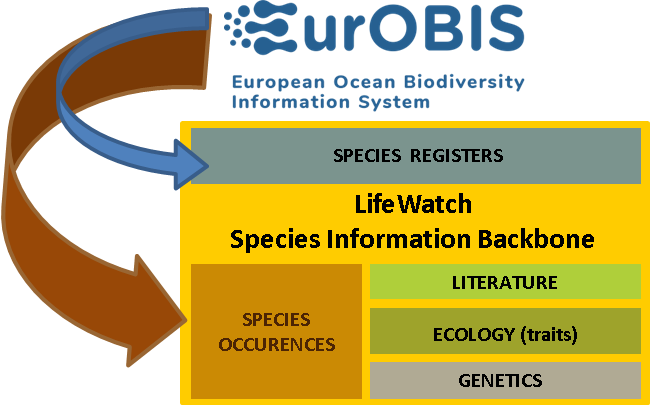LifeWatch
Background
LifeWatch was established as part of the European Strategy Forum on Research Infrastructure (ESFRI) and can be seen as a virtual laboratory for biodiversity research. The concept behind LifeWatch was developed in the 1990s and early 2000s, with the support of EU Networks of Excellence related to biodiversity and ecosystem functioning. This - amongst others - included the MarBEF project, which was the driving project behind the creation of both the European node of the Ocean Biodiversity Information System (EurOBIS) and European Register of Marine Species (ERMS) - the predecessor of the World Register of Marine Species (WoRMS).
Belgium contributes to LifeWatch with varied and complementary "in-kind" contributions. These are implemented under the form of long lasting projects by different research centers and universities spread over the country and supported by each respective political authority. Within LifeWatch, the Flanders Marine Institute - host of the European node of the Ocean Biodiversity Information System - has taken on the responsibility to develop the LifeWatch Species Information Backbone (LW-SIBb).
Mission
The mission of LifeWatch is to advance biodiversity research and to provide major contributions to address the big environmental challenges, such as knowledge-based solutions to environmental managers in the framework of preservation or dealing with long-standing ecological questions that could so far not be addressed due to a lack of data or - more importantly - a lack of good and easy access to data.
The LifeWatch mission is being achieved by giving access to data and information through a single infrastructure which (virtually) brings together a large range and variety of datasets, services and tools. Scientists can use these tools and services to construct so-called Virtual Research Environments (VREs), where they are able to address specific questions related to biodiversity research, including e.g. topics related to preservation.
The construction and operation of the LifeWatch e-infrastructure is revolutionizing the way scientists can do biodiversity research. They are not only offered an environment with unlimited computer and data storing capacity, but there is also transparency at all stages of their research process and the generic application of the e-infrastructure open the door towards more inter- and multidisciplinary research.
LifeWatch Species Information Backbone
The Flanders Marine Institute (VLIZ) is responsible for the set-up of the LifeWatch Species Information Backbone (LW-SIBb), as a central part of the European LifeWatch Infrastructure.
The LW-SIBb aims to (virtually) bring together different component databases and data systems, all of them related to taxonomy, biogeography, ecology, genetics and literature. By doing so, the LW-SIBb standardises species data and integrates biodiversity data from different repositories and operating facilities and is the driving force behind the species information services of the Belgian LifeWatch.be e-Lab that are being developed.
The LifeWatch Species Information Backbone (LW-SIBb) consists of five major components:
EurOBIS contributes to the Species Occurrences part of the LW-SIBb. EurOBIS itself is connected to many other biogeographic data systems, and is one of the major contributors to the international OBIS database (see also 'data flow'). In addition, species names coming from EuROBIS datasets which are not available in WoRMS are communicated with the taxonomic editors of WoRMS, making sure that potential gaps in WoRMS are addressed. |
 |
Through the LW-SIBb, users benefit in several ways, amongst others by:
- Easy access to data and information to a variety of resources, including the European Ocean Biodiversity Information System (Eur)OBIS
- The opportunity to quality control their own data, by cross-checking with data available through the LW-SIBb, e.g. perform a taxon-match against WoRMS, to verify their own species names
- Easy access to a wide range of data services and web services, free to use
- The possibility to combine available services into workflows, and link several systems together (e.g. link taxonomic and traits information from WoRMS with biogeographic information from (Eur)OBIS)
The coordination and development of the LW-SIBb happens at three different levels:
- Setting up a central taxonomic backbone
- Completing and updating the taxonomic and species related data
- Organizing and mobilizing the (taxonomic) experts that provide the data
The work done at all these levels is strongly reflected in the ongoing activities of EurOBIS. The work of the EurOBIS Data Management Team (DMT) collaborates closely with the EurOBIS data providers, by providing data management trainings and to assure the best possible quality of the data flowing to EurOBIS. The DMT is currently being funded through the LifeWatch project and the EMODnet Biology project.
